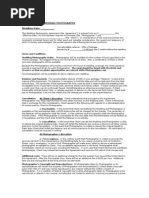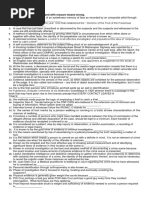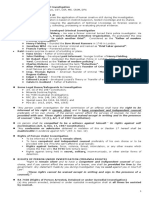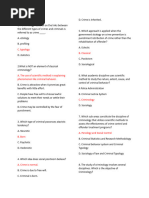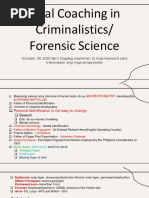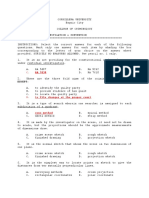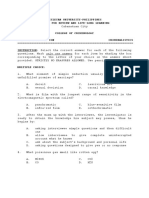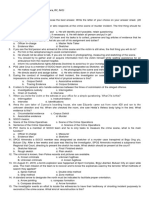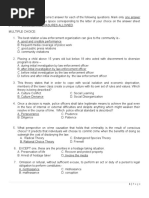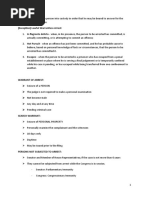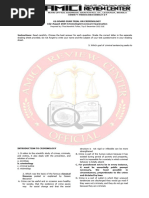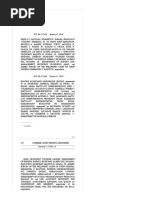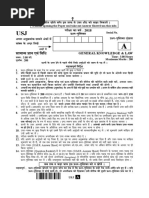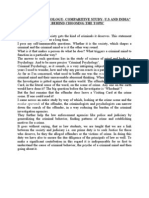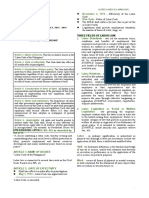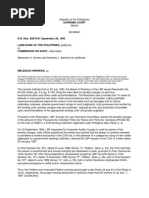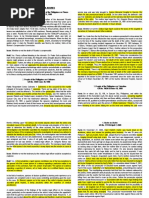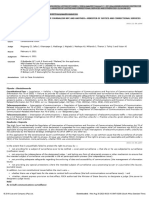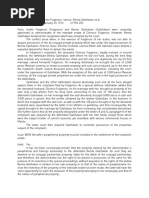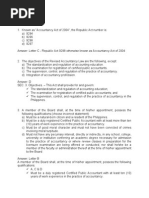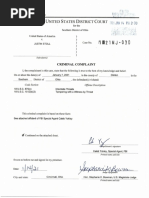0 ratings0% found this document useful (0 votes)
214 viewsCDI Review
CDI Review
Uploaded by
Bimboy CuenoThis document appears to be a sample test for a course on crime detection, investigation and prevention. It contains 51 multiple choice questions testing knowledge on various topics related to criminal investigation procedures, evidence collection and analysis, interrogation techniques, fire investigation, and traffic rules and regulations. The test includes questions about admissibility of evidence, roles of legal officials, types of investigations, surveillance methods, search and seizure, evidence types, case preparation, undercover work, interrogation approaches, crime scene processing techniques, fire behavior, classes of fires, fire codes, and traffic management.
Copyright:
© All Rights Reserved
Available Formats
Download as DOCX, PDF, TXT or read online from Scribd
CDI Review
CDI Review
Uploaded by
Bimboy Cueno0 ratings0% found this document useful (0 votes)
214 views8 pagesThis document appears to be a sample test for a course on crime detection, investigation and prevention. It contains 51 multiple choice questions testing knowledge on various topics related to criminal investigation procedures, evidence collection and analysis, interrogation techniques, fire investigation, and traffic rules and regulations. The test includes questions about admissibility of evidence, roles of legal officials, types of investigations, surveillance methods, search and seizure, evidence types, case preparation, undercover work, interrogation approaches, crime scene processing techniques, fire behavior, classes of fires, fire codes, and traffic management.
Original Description:
Reviewer for Criminal Detection and Investigation
Copyright
© © All Rights Reserved
Available Formats
DOCX, PDF, TXT or read online from Scribd
Share this document
Did you find this document useful?
Is this content inappropriate?
This document appears to be a sample test for a course on crime detection, investigation and prevention. It contains 51 multiple choice questions testing knowledge on various topics related to criminal investigation procedures, evidence collection and analysis, interrogation techniques, fire investigation, and traffic rules and regulations. The test includes questions about admissibility of evidence, roles of legal officials, types of investigations, surveillance methods, search and seizure, evidence types, case preparation, undercover work, interrogation approaches, crime scene processing techniques, fire behavior, classes of fires, fire codes, and traffic management.
Copyright:
© All Rights Reserved
Available Formats
Download as DOCX, PDF, TXT or read online from Scribd
Download as docx, pdf, or txt
0 ratings0% found this document useful (0 votes)
214 views8 pagesCDI Review
CDI Review
Uploaded by
Bimboy CuenoThis document appears to be a sample test for a course on crime detection, investigation and prevention. It contains 51 multiple choice questions testing knowledge on various topics related to criminal investigation procedures, evidence collection and analysis, interrogation techniques, fire investigation, and traffic rules and regulations. The test includes questions about admissibility of evidence, roles of legal officials, types of investigations, surveillance methods, search and seizure, evidence types, case preparation, undercover work, interrogation approaches, crime scene processing techniques, fire behavior, classes of fires, fire codes, and traffic management.
Copyright:
© All Rights Reserved
Available Formats
Download as DOCX, PDF, TXT or read online from Scribd
Download as docx, pdf, or txt
You are on page 1of 8
Name:_________________________________ Course & year Level: ____________
Date: ______________ Score: ______________
Multiple Choice: Below are questions accompanied with different options. Select and encircle the
letter that best corresponds the correct answer.
Crime Detection, Investigation and Prevention Sample Questionnaires:
1. An extra judicial confession obtained from a suspect is admissible in a court of law if it was made
in the presence of a counsel of his own choice and must be in:
A. The presence of a fiscal
B. The presence of a police investigator
C. Writing
D. Front of a judge
2. Fiscals and Prosecutors are under the control and supervision of the
A. National Bureau of Investigation
B. Department of the Interior and Local Government
C. Supreme Court
D. Department of Justice
3. The questioning of a person in a formal and systematic way and is most often used to question
criminal suspects to determine their probable guilt or innocence.
A. Inquiry
B. Interview
C. Polygraph examination
D. Interrogation
4. A form of investigation in which the investigator assume a different and unofficial identity.
A. Tailing
B. Entrapment
C. Espionage
D. Undercover work
5.A type of surveillance in which extreme precautions and actions are taken in not losing the
subject.
A. Loose tail
B. Casing
C. Pony tail
D. Close tail.
6. An examination of an individuals person, houses, or effects or a building, or premises with the
purpose of discovering contraband's or personal properties connected in a crime.
A. Search
B. Raid
C. Investigation
D. Seizure
7. A kind of evidence that tends to prove additional evidence of a different character to the same
point.
A. Corroborative evidence
B. Circumstantial evidence
C. Direct evidence
D. Real evidence
8. The process of bringing together in a logical manner all evidence collected during the
investigation and presents it to the prosecutor.
A. Case preparation
B. Order maintenance
C. Crime prevention
D. Public service
9. Ways and means are resorted for the purpose of trapping and capturing the law breaker during
the execution of a criminal act.
A. Instigation
B. Inducement
C. Buy bust operation
D. Entrapment.
10.A special qualification for an undercover agent.
A. Excellent built
B. Excellent eyesight
C. Excellent looks
D. Excellent memory
11. The discreet observation of places, persons and vehicles for the purpose of obtaining
information concerning the identities or activities of suspects.
A. Close observation
B. Espionage
C. Tailing
D. Surveillance
12. As a general rule, a warrant of arrest can be served at
A. Day time
B. Night time
C. Any day and at any time of the day or night
D. Weekdays
13. A police activity directed toward the identification and apprehension of alleged criminals and
the accumulation, preservation, and presentation of evidence regarding their alleged crimes.
A. Police patrol
B. Police intelligence
C. Criminal procedure
D. Criminal investigation
14. An extension or continuation of the preliminary investigation.
A. Initial investigation
B. Custodial investigation
C. Secondary investigation
D. Follow-up investigation
15. To obtain admission and confession of guilt, is the primary purpose of
A. Interview
B. Surveillance
C. Investigation
D. Interrogation
16. Such facts and circumstances that would lead a reasonably discreet and prudent man to believe
that an offense has been committed and that the object sought in connection with the offense are in
the place sought to be searched.
A. Prima facie evidence
B. Probable cause
C. Prejudicial question
D. Res ipsa loquitur
17. A search warrant shall be valid for _____ days from its date. Thereafter, it shall be void.
A. 10
B. 15
C. 30
D. 45
18. Police seek to prevent crime by being present in places where crimes might be committed and
by alerting citizens to refrain from practices that make them or their property vulnerable.
A. Opportunity denial.
B. Order maintenance
C. Criminal investigation
D. Police intelligence
19. A statement of the suspect directly acknowledging his guilt.
A. Admission
B. Confession
C. Deposition
D. Accusation
19. It may be a direct acknowledgement of the truth of the guilty fact as charge or of some essential
part of the commission of the criminal act itself.
A. Admission
B. Confession
C. Deposition
D. Accusation
20.It may be a self-incriminatory statement by the subject falling short of an acknowledgement of
guilt.
A. Admission
B. Confession
C. Deposition
D. Accusation
21.The simplest type of interview which concerns with the gathering of information regarding the
personal circumstances of a person who is the subject of investigation.
A. Background interview
B. Personal interview
C. Intimate interview
D. Pre-game interview
22. It means method of operation.
A. Corpus delicti
B. Parens patriae
C. Stare decisis
D. Modus operandi
23. It is one which induces the criminal to act and need not be shown in order to obtain conviction.
A. Intent
B. Motive
C. Opportunity
D. Inducement
24. The three tools in criminal investigation, whereby their application varies in proportion on their
necessity to establish the guilt of the accused in a criminal case.
A. Information, interrogation, instrumentation
B. Detection, apprehension, conviction
C. Inquiry, observation, conclusion
D. Magnifying glass, pencil, tape measure
25. The simple questioning of a person who is cooperating in the investigation.
A. Interview
B. Inquiry
C. Interrogation
D. Instrumentation
26. It involves a number of persons who might have handled evidence between the time of the
commission of the alleged offense and the disposition of the case, should be kept to a minimum.
A. Chain of command
B. Chain of custody
C. Evidence tracking
D. Tracing evidence
27. Articles and materials which are found in connection with an investigation and which help in
establishing the identity of the perpetrator or the circumstances under which the crime was
committed or which in general, assist in the prosecution of the criminal.
A. Physical evidence
B. Documentary evidence
C. Tracing evidence
D. Testimonial evidence
28. The following are different techniques in interrogation except one:
A. Sympathetic approach
B. Emotional appeal
C. Financial assistance
D. Friendliness
29.This may be applicable to a crime scene which is approximately circular or oval. The searchers
gather at the center and proceed outward along radii or spokes.
A. Strip method
B. Wheel method
C. Spiral method
D. Zone method
30.The area to be searched is divided into quadrants and each searcher is assigned to one quadrant.
A. Strip method
B. Wheel method
C. Spiral method
D. Zone method
31. The searchers follow each other in the path of a crime scene beginning in the outside and
circling around a central point.
A. Strip method
B. Wheel method
C. Spiral method
D. Zone method
32. A kind of gathering information whereby a subject is being followed.
A. Convoy
B. Caravan
C. Tailing
D. Surveillance
33. Another term for tailing.
A. Impersonating
B. Backing
C. Supporting
D. Shadowing
34. A person who gives necessary information to the investigator. He may give the information
openly and even offer to be a witness or he may inform the investigator surreptitiously and request
to remain anonymous.
A. Witness
B. Expert witness
C. Hostile witness
D. Informant
35. The questioning of persons not suspected of being involved in a crime, but who knows about the
crime or individuals involved in it.
A. Interrogation
B. Rumor mongering
C. Interview
D. Inquiry
36. The primary objective of criminal investigation.
A. Determine the motive
B. Identify criminals.
C. Rehabilitate criminals
D. Prevent crimes
37. A term of the start of the combustion, its detailed process of a solid is very complicated, since
the proportion of different flammable vapors varies from one material to another and contact with
oxygen must take place before combustion can begin.
A. Intensity
B. Ignition.
C. Flash over
D. Starter
38. The term describes the transfer of heat through a gas or vacuum in a similar way to that of light.
A. Ignition
B. Convection
C. Radiation.
D. Conduction
39. The transfer of heat within a solid material from hotter to cooler parts.
A. Ignition
B. Convection
C. Radiation
D. Conduction.
40. The greatest concern of the firemen at the fire/crime scene is to
A. Interview witnesses
B. View the site of the crime
C. Preserve the crime scene
D. Opportunity in the fire/crime scene
41.The primary course of action in case of a fire.
A. Pack up and flee
B. Run for your life
C. Call an ambulance
D. Raise the alarm.
42. The fire resisting property of structural elements and the behavior of a building material in a
fire, it is used to predict how long it will resist the effect of a fire before it fails.
A. Fire resistance
B. Fire duration
C. Fire proof
D. Fire strength
43. A type of fire that is the result of the combustion of certain metals in finely divided forms;
magnesium, potassium, zinc, etc.
A. Class A
B. Class B
C. Class C
D. Class D
44. A type of fire which results from burning of wood, paper, textiles, and other carbonaceous
materials. Extinguishment of this fire is by quenching and cooling.
A. Class A
B. Class B
C. Class C
D. Class D
45. The following are components of fire except one:
A. Gas
B. Fuel
C. Oxygen
D. Heat
46.The irresistible impulse or compulsion to start a fire and experience gratification and
satisfaction from it.
A. Fire starter syndrome
B. Pyrotechnic disease
C. Pyromania
D. Pyrophobia
47. It is known as the Fire Code of the Philippines.
A. PD 1108
B. PD 1017
C. PD 1081
D. PD 1185
48. A type of fire, of flammable liquid and gasses.
A. Class A
B. Class B.
C. Class C
D. Class D
49. The temperature at which a liquid is transformed or converted to vapor.
A. Burning point
B. Melting point.
C. Freezing point
D. Boiling point
50.The movement of vehicles, and pedestrians in a road or highway.
A. Traffic
B. Flight
C. Trip
D. Journey
51. The Traffic and Land Transportation Code of the Philippines
A. RA 7160
B. RA 8551
C. RA 6425
D. RA 4136
52. An occurrence in a sequence of events, which usually produces unintended injury, death or
property damage.
A. Traffic incidents
B. Traffic accidents.
C. Traffic hazards
D. Traffic events
53. An order wherein a violator is commanded to appear in court, but without detaining him.
A. Traffic citation
B. Traffic request
C. Traffic warrant
D. Traffic violation
54.The following are the five Es of Traffic Management and Operation except one:
A. Engineering
B. Education
C. Enforcement
D. Environment
E. Economy
D. Evaluation
55. The Comprehensive Dangerous Drugs Act of 2002.
A. RA 9870
B. RA 9165
C. RA 1017
D. RA 6195
56.Drugs that produce perceptual alteration, varying emotional change, thought disruption and ego
distortion. They are called psychedelics.
A. Tranquillizers
B. Hallucinogens.
C. Stimulants
D. Depressants
57.The practice or profession of having sexual intercourse for money or profit.
A. Gynecology
B. Prostitution
C. White Slavery
D. Sex Trade
58.The scientific name of Indian hemp plant.
A. Cannabis sativa L
B. Papaver somniforum
C. Deoxyribonucleic acid
D. Methamphetamine HCl Answer: A
59. It is chemically known as methamphetamine hydro chloride.
A. Heroin
B. Codeine
C. Morphine
D. None of these
60.Any chemical substance that by virtue of its chemical nature alters the structure and functioning
of living organism.
A. Alcohol
B. Poison
C. Drug
D. Vice Answer: C
You might also like
- Wedding ContractDocument3 pagesWedding Contractinspiredart100% (4)
- New Final Memorial PDFDocument16 pagesNew Final Memorial PDFGowri100% (1)
- CONTRACT To Sell TambalDocument4 pagesCONTRACT To Sell TambalEppie SeverinoNo ratings yet
- Cdi Set BDocument101 pagesCdi Set BHarrison sajorNo ratings yet
- Cdi Reviewer Ni TorredesDocument22 pagesCdi Reviewer Ni TorredesClobelle Beronia100% (1)
- Mockboard Exam in Crim SocDocument10 pagesMockboard Exam in Crim SocnielNo ratings yet
- Cdi1 LQDocument4 pagesCdi1 LQLoise SalasNo ratings yet
- Crime Detection and Investigation ReviewerDocument8 pagesCrime Detection and Investigation Reviewersantos.johnlenardNo ratings yet
- Pre Test 2020 CoradDocument3 pagesPre Test 2020 CoradJamella GarzonNo ratings yet
- Criminal Jurisprudence Procedure and Evidence (20%)Document13 pagesCriminal Jurisprudence Procedure and Evidence (20%)RODOLFO JR. CASTILLONo ratings yet
- Post Test in Fundamentals of Criminal Investigation and IntelligenceDocument6 pagesPost Test in Fundamentals of Criminal Investigation and Intelligencejohn diezNo ratings yet
- CDI ManwongDocument167 pagesCDI ManwongJan Open MiharNo ratings yet
- Cdi QuestionsDocument4 pagesCdi Questionsnotgacount000No ratings yet
- Review Questions in Law Enforcement Administration Set One INSTRUCTION: Select The Correct Answer For Each of The FollowingDocument30 pagesReview Questions in Law Enforcement Administration Set One INSTRUCTION: Select The Correct Answer For Each of The FollowingChester CuarentasNo ratings yet
- Specialized Module-6Document10 pagesSpecialized Module-6Hanely De La PeñaNo ratings yet
- CDI 103 - Special CIDocument7 pagesCDI 103 - Special CIrenjomarNo ratings yet
- Coad Final Coaching With KeyDocument55 pagesCoad Final Coaching With KeyLioliza Mae G. ValdezNo ratings yet
- Crime Detection and InvestigationDocument4 pagesCrime Detection and InvestigationZefren BotillaNo ratings yet
- Mock Board CLJDocument5 pagesMock Board CLJXandredg Sumpt LatogNo ratings yet
- Cep CrimsocnotesDocument71 pagesCep CrimsocnotesHarrison sajorNo ratings yet
- Pretest in Crime Detection, Investigation and PreventionDocument14 pagesPretest in Crime Detection, Investigation and PreventionMa Roxan DanoNo ratings yet
- Civil Service Exam Complete Reviewer Philippines 2017Document8 pagesCivil Service Exam Complete Reviewer Philippines 2017Cindy Bacsal TrajeraNo ratings yet
- Amici Review Center - LEADocument8 pagesAmici Review Center - LEAFrestel Mae Failagao GarciaNo ratings yet
- 2Document13 pages2Jake CopradeNo ratings yet
- Q and A FCI SCI TAIDocument23 pagesQ and A FCI SCI TAIJennifer Rose BauzonNo ratings yet
- Review Notes On Introduction To CriminologyDocument7 pagesReview Notes On Introduction To CriminologyOka DeeNo ratings yet
- Mid Ca2 Lesson 13Document15 pagesMid Ca2 Lesson 13kiyoihira2003No ratings yet
- Criminology LMTDocument11 pagesCriminology LMTreal.cjbarayuga09No ratings yet
- CDI - Set BDocument10 pagesCDI - Set BRODOLFO JR. CASTILLONo ratings yet
- Actual CLE With Not Sure AnswersDocument8 pagesActual CLE With Not Sure AnswersCherry Ann ValdezNo ratings yet
- CDI For UC 2021 BLEC Crash ReviewDocument416 pagesCDI For UC 2021 BLEC Crash ReviewXian DondiNo ratings yet
- I Am Sharing Final Coaching in Criminalistics 1 With YouDocument20 pagesI Am Sharing Final Coaching in Criminalistics 1 With YouMae Lin Sarah-anneNo ratings yet
- ExceptDocument14 pagesExceptNor-Alissa M Diso0% (1)
- Module 2. CLBDocument4 pagesModule 2. CLBFrances ChugyawiNo ratings yet
- MODULE 7 Specialized Crime Investigation 2Document14 pagesMODULE 7 Specialized Crime Investigation 2Kay KUaNo ratings yet
- CriminalisticsDocument15 pagesCriminalisticscriminologyallianceNo ratings yet
- QNA COMPILATION DioDocument167 pagesQNA COMPILATION DioJesmar LoboNo ratings yet
- Cdi 101 FinalDocument3 pagesCdi 101 Finalmarife bucioNo ratings yet
- Module in Fire Technology and Arson Investigation (Cdi 6)Document4 pagesModule in Fire Technology and Arson Investigation (Cdi 6)Givehart Mira BanlasanNo ratings yet
- Criminology Refresher ReviewerDocument99 pagesCriminology Refresher Reviewerlea karen GelidoNo ratings yet
- Crime Detection1-XDocument7 pagesCrime Detection1-XTSD ANNEXNo ratings yet
- MODULE 6 Specialized Crime Investigation 2Document3 pagesMODULE 6 Specialized Crime Investigation 2Kay KUaNo ratings yet
- Diagnostics Crim Dec2022Document3 pagesDiagnostics Crim Dec2022RODOLFO JR. CASTILLO100% (1)
- Crim 4Document7 pagesCrim 4Al FernandezNo ratings yet
- CLJ 6 Prelims ReviewerDocument2 pagesCLJ 6 Prelims ReviewerRAMIREZ JIANE JADE C.No ratings yet
- Special Crime Q&ADocument9 pagesSpecial Crime Q&AKatti de LumenNo ratings yet
- Fund. of Crim. Inves.Document70 pagesFund. of Crim. Inves.Frederick EboñaNo ratings yet
- FINALS InstitutionalDocument20 pagesFINALS InstitutionalpartaannannNo ratings yet
- Cdi 3 Special CrimeDocument21 pagesCdi 3 Special CrimeGian Antonio L. AbdonNo ratings yet
- Intro To Crim QnaDocument55 pagesIntro To Crim QnaDaphney Claire Pineda100% (1)
- 2 Criminalistics Review QuestionsDocument16 pages2 Criminalistics Review QuestionsAli Zafrullah Daud Binudin100% (1)
- g2 Jul Aug2024 Crim Bet by Prof. Toliao Answer KeyDocument82 pagesg2 Jul Aug2024 Crim Bet by Prof. Toliao Answer KeyNorsidah DomatoNo ratings yet
- Cri 412 - Uloa SimDocument32 pagesCri 412 - Uloa SimDaniel Tajas BorromeoNo ratings yet
- It Is A Person A Tasked or A Duty of Carrying Out of The Objectives in InvestigationDocument23 pagesIt Is A Person A Tasked or A Duty of Carrying Out of The Objectives in InvestigationKristel YeenNo ratings yet
- Law Enforcement and AdministrationDocument60 pagesLaw Enforcement and AdministrationEmersan OndingNo ratings yet
- Cybercrime Processing Bag and Tag ProdedureDocument68 pagesCybercrime Processing Bag and Tag ProdedureHerman ClederaNo ratings yet
- 2 Final Briefing Cdi 2015Document16 pages2 Final Briefing Cdi 2015Johnpatrick DejesusNo ratings yet
- TG #2 Cri 179Document9 pagesTG #2 Cri 179Jeyromme DomingoNo ratings yet
- Final Coaching Correctional Administration - Mr. CrimiKNOWlogyDocument156 pagesFinal Coaching Correctional Administration - Mr. CrimiKNOWlogyEugene AguilarNo ratings yet
- Analyzing Test Items: Part 2-Analyzing Test Items Multiplechoice Direction:Choosethe Letter of The Best AnswerDocument6 pagesAnalyzing Test Items: Part 2-Analyzing Test Items Multiplechoice Direction:Choosethe Letter of The Best Answerjiovanne jadman100% (1)
- C. A. 2 Non InstitutionalDocument12 pagesC. A. 2 Non InstitutionalKristina RebatoNo ratings yet
- Cdi Compendium PDFDocument75 pagesCdi Compendium PDFedmerson manuel100% (1)
- Crime Detection Review QuestionsDocument14 pagesCrime Detection Review QuestionsYhennie ICee CristobalNo ratings yet
- Mohamed Abdulmohsen Al-Kharafi & Sons Co. v. The Government of The State of Libya and Others, Final ..Document78 pagesMohamed Abdulmohsen Al-Kharafi & Sons Co. v. The Government of The State of Libya and Others, Final ..Yasmine DoctoranteNo ratings yet
- 10 Saguisag v. Executive Secretary, G.R. No. 212426, January 12, 2016 - ScraDocument299 pages10 Saguisag v. Executive Secretary, G.R. No. 212426, January 12, 2016 - ScraJNo ratings yet
- PCSJ Question PaperDocument40 pagesPCSJ Question PaperSanju YadavNo ratings yet
- Compliance Affidavit For MBBS Interns1Document3 pagesCompliance Affidavit For MBBS Interns1Ryan SoaresNo ratings yet
- Conflicts of LawDocument75 pagesConflicts of Lawelizafaith100% (1)
- Unidroit y DRAFTDocument48 pagesUnidroit y DRAFTCarlos MartinezNo ratings yet
- Criminal PsychologyDocument2 pagesCriminal PsychologyRamneek Singh SalujaNo ratings yet
- LABOR 1 (2021-2022, ARB) - PreMidterm NotesDocument31 pagesLABOR 1 (2021-2022, ARB) - PreMidterm NotesSamantha Amielle CanilloNo ratings yet
- 168048-2013-Tadeja v. PeopleDocument10 pages168048-2013-Tadeja v. PeopleTintin SumawayNo ratings yet
- Land Bank of The Philippines v. COA, 190 SCRA 154 (1990)Document4 pagesLand Bank of The Philippines v. COA, 190 SCRA 154 (1990)Gwyneth SantosNo ratings yet
- Myanmar Companies Law 2017Document188 pagesMyanmar Companies Law 2017Let's Save Myanmar100% (1)
- Mba-Sem Iii MB0035 - Legal Aspects of Business - 4 CreditsDocument9 pagesMba-Sem Iii MB0035 - Legal Aspects of Business - 4 CreditsSudha Amit Thakur100% (1)
- United States v. Ging-Hwang Tsoa, 4th Cir. (2014)Document11 pagesUnited States v. Ging-Hwang Tsoa, 4th Cir. (2014)Scribd Government DocsNo ratings yet
- Finals CasesDocument22 pagesFinals Caseslee matiasNo ratings yet
- AMABHUNGANE CENTRE FOR INVESTIGATIVE JOURNALISM NPC AND ANOTHER V MINISTER OF JUSTICE AND CORRECTIONAL SERVICES AND OTHERS 2021 (3) SA 246 (CC)Document28 pagesAMABHUNGANE CENTRE FOR INVESTIGATIVE JOURNALISM NPC AND ANOTHER V MINISTER OF JUSTICE AND CORRECTIONAL SERVICES AND OTHERS 2021 (3) SA 246 (CC)Bessie RamorogoNo ratings yet
- MCQ (New Topics-Special Laws) - PartDocument2 pagesMCQ (New Topics-Special Laws) - PartJEP WalwalNo ratings yet
- European Journal of Pharmaceutical and Medical Research (Ejpmr)Document2 pagesEuropean Journal of Pharmaceutical and Medical Research (Ejpmr)weni puspitaNo ratings yet
- Fulgencio Vs Gatchalian Case DigestDocument2 pagesFulgencio Vs Gatchalian Case DigestEllen Glae DaquipilNo ratings yet
- Model Special Power of AttorneyDocument2 pagesModel Special Power of AttorneyVirginia GapuzNo ratings yet
- BUSN623 Google LLC Legal & Regulation Challenges Within The European UnionDocument23 pagesBUSN623 Google LLC Legal & Regulation Challenges Within The European Unionjwbizz08No ratings yet
- ComplaintDocument5 pagesComplaintDione GuevaraNo ratings yet
- Accountancy Law (Q&A)Document8 pagesAccountancy Law (Q&A)Rosario Garcia CatugasNo ratings yet
- STOLL - Filed Complaint (Under Seal)Document9 pagesSTOLL - Filed Complaint (Under Seal)Josh RichardsonNo ratings yet
- Phil First Insurance vs. Wallem First ShippingDocument3 pagesPhil First Insurance vs. Wallem First ShippingMary Grace G. EscabelNo ratings yet
- Eo 423-2005Document5 pagesEo 423-2005markdaveNo ratings yet
- 2019 Constitutional Law I ARTICLE 6 & 7Document5 pages2019 Constitutional Law I ARTICLE 6 & 7shopee onlineNo ratings yet
- Application For Employment FormDocument3 pagesApplication For Employment FormLegal FormsNo ratings yet
